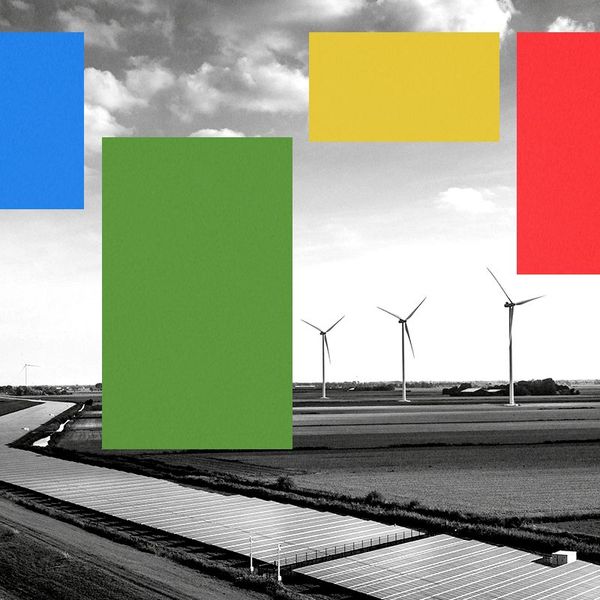New York Governor Kathy Hochul inked a partnership agreement with Ontario Premier Doug Ford on Friday to work together on establishing supply chains and best practices for deploying next-generation nuclear technology. Unlike many other states whose formal pronouncements about nuclear power are limited to as-yet-unbuilt small modular reactors, the document promised to establish “a framework for collaboration on the development of advanced nuclear technologies, including large-scale nuclear” and SMRs. Ontario’s government-owned utility just broke ground on what could be the continent’s first SMR, a 300-megawatt reactor with a traditional, water-cooled design at the Darlington nuclear plant. New York, meanwhile, has vowed to build at least 1 gigawatt of new nuclear power in the state through its government-owned New York Power Authority. Heatmap’s Matthew Zeitlin wrote about the similarities between the two state-controlled utilities back when New York announced its plans. “This first-of-its-kind agreement represents a bold step forward in our relationship and New York’s pursuit of a clean energy future,” Hochul said in a press release. “By partnering with Ontario Power Generation and its extensive nuclear experience, New York is positioning itself at the forefront of advanced nuclear technology deployment, ensuring we have safe, reliable, affordable, and carbon-free energy that will help power the jobs of tomorrow.”
Hochul is on something of a roll. She also repealed a rule that’s been on the books for nearly 140 years that provided free hookups to the gas system for new customers in the state. The so-called 100-foot-rule is a reference to how much pipe the state would subsidize. The out-of-pocket cost for builders to link to the local gas network will likely be thousands of dollars, putting the alternative of using electric heat and cooking appliances on a level playing field. “It’s simply unfair, especially when so many people are struggling right now, to expect existing utility ratepayers to foot the bill for a gas hookup at a brand new house that is not their own,” Hochul said in a statement. “I have made affordability a top priority and doing away with this 40-year-old subsidy that has outlived its purpose will help with that.”
2. Redwood Materials starts producing critical minerals
Redwood Materials, the battery recycling startup led by Tesla cofounder J.B. Straubel, has entered into commercial production at its South Carolina facility. The first phase of the $3.5 billion plant “has brought a system online that’s capable of recovering 20,000 metric tons of critical minerals annually, which isn’t full capacity,” Sawyer Merritt, a Tesla investor, posted on X. “Redwood’s goal is to keep these resources here; recovered, refined, and redeployed for America’s advantage,” the company wrote in a blog post on its website. “This strategy turns yesterday’s imports into tomorrow’s strategic stockpile, making the U.S. stronger, more competitive, and less vulnerable to supply chains controlled by China and other foreign adversaries.”
3. 13 states launch initiative to speed up geothermal deployments
A 13-state alliance at the National Association of State Energy Officials launched a new accelerator program Friday that’s meant to “rapidly expand geothermal power development.” The effort, led by state energy offices in Arizona, California, Colorado, Hawaii, Idaho, Louisiana, Montana, Nevada, New Mexico, Oregon, Pennsylvania, Utah, and West Virginia, “will work to establish statewide geothermal power goals and to advance policies and programs that reduce project costs, address regulatory barriers, and speed the deployment of reliable, firm, flexible power to the grid.” Statements from governors of red and blue states highlighted the energy source’s bipartisan appeal. California Governor Gavin Newsom, a Democrat, called geothermal a key tool to “confront the climate crisis.” Idaho’s GOP Governor Brad Little, meanwhile, said geothermal power “strengthens communities, supports economic growth, and keeps our grid resilient.” If you want to review why geothermal is making a comeback, read this piece by Matthew.
Sign up to receive Heatmap AM in your inbox every morning:
4. FERC advances a new gas pipeline
Yet another pipeline is getting the greenlight. Last week, the Federal Energy Regulatory Commission approved plans for Mountain Valley’s Southgate pipeline, clearing the way for construction. The move to shorten the pipeline’s length from 75 miles down to 31 miles, while increasing the diameter of the project to 30 inches from between 16 and 23 inches, hinged on whether FERC deemed the gas conduit necessary. On Thursday, E&E News reported, FERC said the developers had demonstrated a need for the pipeline stretching from the existing Mountain Valley pipeline into North Carolina.
5. India passes landmark bill to open nuclear sector to private companies
Last week, I told you about a bill proposed in India’s parliament to reform the country’s civil liability law and open the nuclear industry to foreign companies. In the 2010s, India passed a law designed to avoid another disaster like the 1984 Bhopal chemical leak that killed thousands but largely gave the subsidiary of the Dow Chemical Corporation that was responsible for the accident a pass on payouts to victims. As a result, virtually no foreign nuclear companies wanted to operate in India, lest an accident result in astronomical legal expenses in the country. (The one exception was Russia’s state-owned Rosatom.) In a bid to attract Western reactor companies, Indian lawmakers in both houses of parliament voted to repeal the liability provisions, NucNet reported.
THE KICKER
The critically endangered Lesser Antillean iguana has made a stunning recovery on the tiny, uninhabited islet of Prickly Pear East near Anguilla. A population of roughly 10 breeding-aged lizards ballooned to 500 in the past five years. “Prickly Pear East has become a beacon of hope for these gorgeous lizards — and proves that when we give native wildlife the chance, they know what to do,” Jenny Daltry, Caribbean Alliance Director of nature charities Fauna & Flora and Re:wild, told Euronews.







 New York Governor Kathy Hochul. John Lamparski/Getty Images for Concordia Annual Summit
New York Governor Kathy Hochul. John Lamparski/Getty Images for Concordia Annual Summit